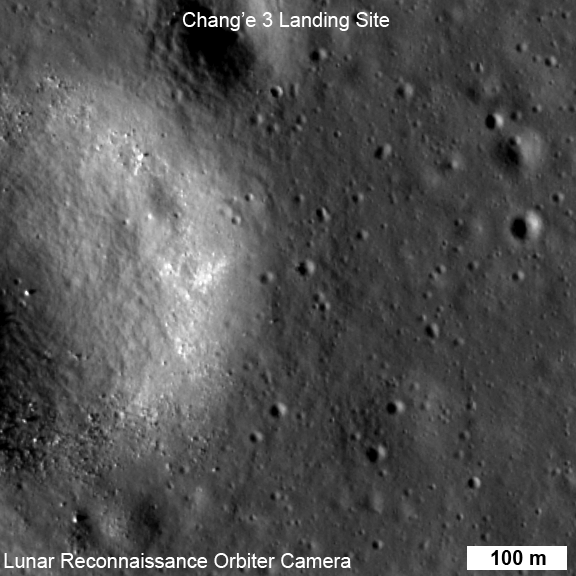.

The lander (top arrow) and Yutu (bottom arrow) cast shadows across the Lunar "soil"
.
An American satellite has pictured the Chinese Yutu rover on the surface of the Moon.
The 150cm-wide wheeled-vehicle appears as a single pixel in the images from the US space agency's (Nasa) Lunar Reconnaissance Orbiter (LRO).
The lander that placed Yutu on the surface of Mare Imbrium (Sea of Rains) on 14 December is also visible nearby.
Both pieces of Chinese hardware are distinctively bright against the dark lunar "soil" and cast long shadows.
This made them easy to identify in before-and-after images of the landing location, which can now be given very precise map coordinates.
Nasa says its LRO satellite was not in the right position to capture the landing earlier this month. Only by 25 December had the spacecraft's orbit brought it directly overhead.
The published images were taken from an altitude of 150km.
Yutu ("Jade Rabbit") is China's first mission to make a soft landing at the Moon. After running down a ramp on to the lunar surface, Yutu trundled in an arc around its delivery lander.
Scientists were able to check the vehicle's systems before putting the robot into hibernation for the long lunar night, which lasts two Earth weeks.
When revived, Yutu will explore its landing zone, studying the dusty terrain and its geology.
Quelle: BBC
.
NASA Images of Chang'e 3 Landing Site

Chang'e 3 landed on Mare Imbrium (Sea of Rains) just east of a 450 m diameter impact crater on 14 December 2013. Soon after landing, a small rover named Yutu (or Jade Rabbit in English) was deployed and took its first tentative drive onto the airless regolith. At the time of the landing LRO's orbit was far from the landing site so images of the landing were not possible. Ten days later on 24 December, LRO approached the landing site, and LROC was able to acquire a series of six LROC Narrow Angle Camera ( NAC ) image pairs during the next 36 hours (19 orbits). The highest resolution image was possible when LRO was nearly overhead on 25 December 03:52:49 UT (24 December 22:52:49 EST). At this time LRO was at an altitude of ~150 km above the site, and the pixel size was 150 cm.
The rover is only about 150 cm wide, yet it shows up in the NAC images for two reasons: the solar panels are very effective at reflecting light so the rover shows up as two bright pixels, and the Sun is setting thus the rover casts a distinct shadow (as does the lander). Since the rover is close to the size of a pixel, how can we be sure we are seeing the rover and not a comparably sized boulder? Fortuitously, the NAC acquired a "before" image (M1127248516R) of the landing site, with nearly identical lighting, on 30 June 2013. By comparing the before and after landing site images, the LROC team confirmed the position of the lander and rover, and derived accurate map coordinates for the lander (44.1214°N, 340.4884°E, 2640 meters elevation ).
The lander set down about 60 meters east of the rim of a 450 meter diameter impact crater (40 meters deep) on a thick deposit of volcanic materials. A large scale wrinkle ridge (~100 km long, 10 km wide) cuts across the area and was formed as tectonic stress caused the volcanic layers to buckle and break along faults. Wrinkle ridges are common on the Moon, Mercury and Mars.
Lunar mare basalts are divided into two main spectral (color) types: "red" and "blue" (blue is perhaps a misnomer, think "less red"). Basalts on the Moon (same on Earth) are composed mainly of two minerals, pyroxene and plagioclase, though olivine and ilmenite can sometimes occur in significant amounts. The presence of ilmenite (FeTiO 3 ) results in lower reflectance and a "lessred" color thus the blue basalts. The landing site is on a blue mare (higher titanium) thought to be about 3.0 billion years old. The boundary (black arrows in above WAC mosaic) with an older (3.5 billion years) red mare is only 10 km to the north.
.




